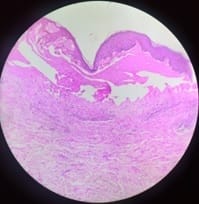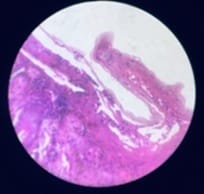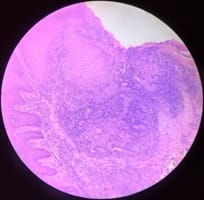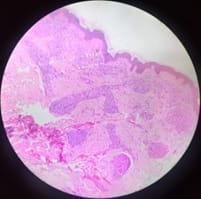Histopathological study of non-neoplastic skin lesions in a tertiary care center
Vijayasankar S.1, Rohit Mathew L.2*, Alavandhar E.3, Vijayalakshmi C. S.4
DOI: https://doi.org/10.17511/jopm.2020.i06.05
1 Sridevi Vijayasankar, Associate Professor, Department of Pathology, Sri Muthukumaran Medical College and Hospital and Research Institute, Chennai, Tamil Nadu, India.
2* Lionel Rohit Mathew, Assistant Professor, Department of Pathology, Sri Muthukumaran Medical College and Hospital and Research Institute, Chennai, Tamil Nadu, India.
3 Ezhilvizhi Alavandhar, Professor, Department of Pathology, Sri Muthukumaran Medical College and Hospital and Research Institute, Chennai, Tamil Nadu, India.
4 Vijayalakshmi C. S., Professor and HOD, Department of Pathology, Sri Muthukumaran Medical College and Hospital and Research Institute, Chennai, Tamil Nadu, India.
Introduction: Skin is the largest organ of our body. Non-neoplastic skin lesions are more common than neoplastic lesions. The histopathological study was done to know the prevalence of various non-neoplastic skin lesions of patients who attended the outpatient department of dermatology over a period of three years from Jan 2016-Dec2018. Materials and Methods: In this study total of 209 cases of skin lesions were taken over a period of three years. The diagnosis of these skin lesions was confirmed by histopathological examination with routine hematoxylin and eosin stain. Results: A total of 209 cases of non-neoplastic lesions were taken for the study. Out of these lesions, 63 cases (30.14 %) were non-infectious - vesiculobullous, 54 ( 25.84 %) were reported under the category of infectious etiology, 41 cases (19.62 %) of non-infectious erythematous papulosquamous diseases, 13 cases (6.22 %) of inflammatory disorders, 10 (4.78%) cases showed connective tissue disorders. 8(3.83%) cases were reported as vasculitis and 2 cases (0.96) of fungal origin. 18 cases come under the miscellaneous category that was correlated clinically and were treated. Conclusion: In the present study of non-neoplastic skin lesions, non-infectious vesiculobullous diseases were more common. Pemphigus Vulgaris was the most common lesion. The non-neoplastic skin lesions were most commonly seen in males than females in our population of the study.
Keywords: Histopathology, Haematoxylin and eosin, Non-neoplastic skin lesions, Noninfectious vesiculobullous diseases
| Corresponding Author | How to Cite this Article | To Browse |
|---|---|---|
| , Assistant Professor, Department of Pathology, Sri Muthukumaran Medical College and Hospital and Research Institute, Chennai, Tamil Nadu, India. Email: |
Vijayasankar S, Mathew LR, Alavandhar E, Vijayalakshmi CS. Histopathological study of non-neoplastic skin lesions in a tertiary care center. Trop J Pathol Microbiol. 2020;6(6):395-400. Available From https://pathology.medresearch.in/index.php/jopm/article/view/470 |


 ©
© 


